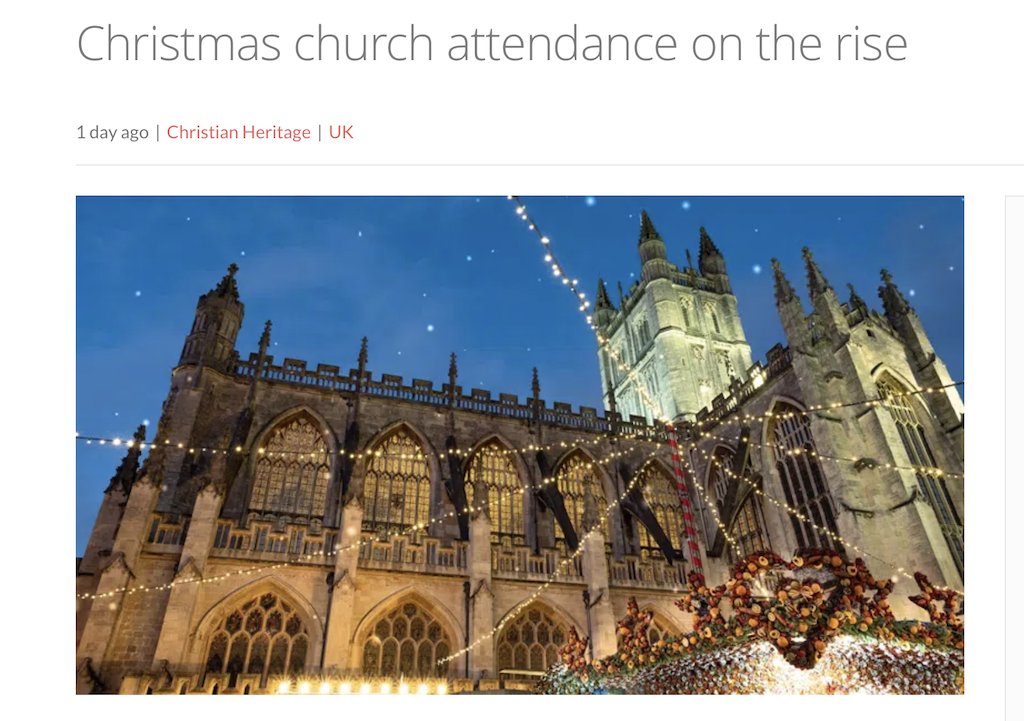June 27, 2017
51 per cent of us are Christian? Yeah, right!
There’s as much chance that 51 per cent of Australians are Christian as there are that fifty per cent of our young people are gender fluid when it comes to their sexuality.
The latest research from the Australian Bureau of Statistics from that census (you know, the one we were all in self-loathing anguish about last year because of its failed roll out, but which still returned a statistically high 95.1 per cent response rate), shows that just over half the population loves Jesus and serves him and others; is involved in Christian community regularly; practices repentance on a daily basis; gives sacrificially on the basis of Christ’s sacrifice for them; assents to the traditional doctrines of the Church; and longs for his appearing, when he will judge the world in righteousness and usher in the new creation under his kingship.
Well, now that you put it like that….
You see, there’s every chance the same crowd that pounces on this misleading 51 per cent stat to say “You see, we are a Christian country after all!”, is the same crowd that pounces on sexual revolutionary and Safe Schools advocate Ros Ward and her stat claiming half our kids are gender fluid and says “Nonsense.”
Both claims are wishful thinking. Both claims are seeking wish fulfilment. Both claims are claims that don’t stand up to reality. Both need to be more honest than that.
The fact is identity with the Christian faith – never mind an adherence to what I stated above – is in free fall. The ABS shows that since 1991 there has been a 22 per cent drop in the number of people claiming to be Christian. And for the first time the number of “no religion” adherents (or at least those who can’t see how religious they actually are – take a bow David Foster Wallace), is greater than the percentage of Catholics, 29.6 per cent to 22.6 per cent.
Last year before the census I queried a campaign that encouraged people to tick the “Christian” box even if they merely adhered to so-called “Christian values” but never went near a church. The nice shiny happy family on the glossy ad looked so inviting, almost more inviting than Jesus. Why wouldn’t you want to be like them?
Yet what many Christian leaders love in stats, they hate in actuality. More than a decade ago Christian Smith in his ground breaking study Soul Searching: The Religious and Spiritual Lives of American Teenagers, coined the term “moralistic, therapeutic deism” (MTD) to describe the spirituality of the new generation in the USA.
According to Smith there are five markers of MTD:
1. A god exists who created and ordered the world and watches over human life on earth.
2. God wants people to be good, nice, and fair to each other, as taught in the Bible and by most world religions.
3.The central goal of life is to be happy and to feel good about oneself.
4.God does not need to be particularly involved in one’s life except when God is needed to resolve a problem.
5.Good people go to heaven when they die.
It’s safe to say that such thinking doesn’t strengthen the church proper, but enervates it, and lulls uncritical thinkers into a false sense that it will all be okay. And it’s safe to say such thinking is the bane of many a ministry leader who finds that the gospel just bounces off people’s own agendas when it comes to proclaiming the purpose and telos of life. The most frustrating crowd in church – when they turn up – are they MTD-ers; their impenetrable shell impervious to the call to take up a cross daily and die. Why die to the self, when there are so many funky ways to fulfil it?
It’s also safe to say a sizeable chunk of that 51 percent who ticked Christian would perhaps have ticked MTD if it were explained to them. Most would never be so bold, even in an anonymous survey, to tick “No Religion”, but a MTD choice sounds pretty acceptable. They would have gone “Ah, now that you put it like that…”
And because of that it’s safe to say a sizeable chunk also agree with Ward, whether it’s true or not, that gender is actually fluid – if you want it to be. After all, if point three of MTD stands true, then if it makes you happy and feel good about yourself, why not?
Of course the other stat that gets bandied about all of the time these days is the fact that more people go to church on Sunday than go to an AFL match on a weekend.
Maybe, and it sounds impressive. You sit back after hearing that stat and imagine all those MCGs full of worshipping Christians. It sounds nice. It keeps the bad at bay.
But when six hours of talk back radio and ten pages of the local paper are devoted to what might happen at church on Sunday, and then an equal number of hours and pages on Monday are devoted to what did happen at church on Sunday; the winners, the losers, who got rubbed out for some sin real or imagined, the defeat of the Demons, the victory of the Saints etc, then maybe we can start to take the stat seriously.
Besides if AFL is the pinnacle of the sport, played in the cathedrals of football, then lets compare the AFL attendance with average cathedral attendance in Australia over the weekend. Your local evangelical independent church? That’ Oz-kick right there. And once we factor grassroots into it, we’re looking a lot less religious than the football.
And then, just to ice the cake with a particularly violently coloured ganache, across all institutions in the West, secular as well as religious, meaningful participation is in free fall. Regular attendance at church is now considered to be twice a month. Not twice a month at church added to the plethora of other church activities one could be involved in, but twice – period. We’re not only getting smaller, we’re getting thinner. Just like an old person.
I’m no pessimist, nor am I an optimist, when it comes to such stats. It’s simply that reality is worth staring at and taking in. We need to heed a lesson from one of our own evangelistic examples. You know the one about the blood disorder? Sin isn’t solved by sticking a bandaid on a rash caused by a blood disease. No, the bandaid is masking the problem not solving the problem.
So let’s not look at the stats and do the same thing. Stick another event over here or there. That’s just masking the haemorrhage we face in the Church.
Interestingly it might be a couple of other startling stats, which on the face of them have nothing to do with religion, that might point a way forward for us. Since 2011 a huge 664, 473 Australians passed the age of 65, with the stats pointing to a “middle aged bulge” above fifty.
The white Boomer European Christian-by-default- is on his or her way out. A new Australian is taking their place. And not only are there almost 47, 000 same sex couples (an increase of 39 per cent in the past five years), but almost thirty percent of the migrant population of the last five years hails from either China or India.
That tells me this. Less and less people are going to lazily tick the Christian box in the future. If you’re going to tick it you’re going to have to mean it. And really mean it. Not in some Christianised MTD way, but in a considered, thoughtful way.
And that presents us with a gospel opportunity, because the stats show that the world that has never heard the gospel – or even the caricature of it that so many Westerners are rejecting – is coming to us. And anecdotally this rings true. By far the most meaningful conversations I have had about religion in Australia these past three or four years are with new migrants, especially young Muslim men, and especially young Muslim men driving taxis who chat to lots and lots of us every day.
And despite all of the wonder at the growth of the Chinese church in mainland China, the vast majority of mainland Chinese have zero understanding of Christianity simply because, unlike our context, it’s not the foundation of their culture. If you haven’t gone looking for Christianity in China, it hasn’t been presenting itself in flyers on the wall and history books in school.
Hence this growing crowd of migrants will be much more open to hearing about Jesus for the first time than the average MTD thirty-something who has learned everything they know about the church from The Project.
But perhaps my most significant thought about religion in Australia this week had nothing to do with statistics. On Saturday, with my daughter and I in town to purchase her first pair of Doc Martens (funky t-bar shoes with yellow stitching, thanks for asking), we stopped and had a chat with the blokes wearing the “I’m a Muslim. Ask Me Anything” lads who were standing in the main pedestrian mall, chatting with people and videoing their responses.
Once they heard I was a pastor they directed me to the imam who was coordinating it all, a young bloke in his thirties was actually from Leicester in the UK. He was friendly, charismatic, well educated and culturally savvy. We chatted about faith in Australia, the lack of religious conversations, and the fact that when people’s lives are surrounded by comforts, the topic of God rarely comes up. He and I are going to have coffee in the city soon to chat further.
He said an interesting thing: “It’s hard to explain God to people who have not experienced him.” The scandal of particularity is still the scandal I am committed to, but it was a probing comment nonetheless.
And as we talked, my daughter and I noticed just how many people were stopping to ask quesitons. To ask them “anything”, I presume. There was a genuine interest for people in this thing that was mysterious, counter-cultural, with strong boundaries and no recognition of a sacred/secular divide. Something they had heard of before, but were under no illusions that they belonged to.
When we walked away my daughter turned and said to me “I wonder how it would go if it had been us wearing teeshirts with ‘I’m a Christian. Ask Me Anything’?”
And we had a chat on the train about what it would mean for her growing up in a world hardening against the Christian faith, a world in which she will have to push harder against the aggressive secular frame than I have had to, but with the same resources.
I wonder what percentage will unthinkingly tick the Christian box in 26 years time when my daughter is 42? The free fall of the last 26 years should tell us how many, all things being equal.
Which they’re not. Not equal, I mean.
I’m longing for the day when such a teeshirt and stall in the mall doesn’t simply elicit a tired old wave of the hand from people who don’t want to be hassled, or a rant about something Christians have spectacularly failed at.
I’m longing for the day when it once again elicits a genuine curiosity about something that is mysterious, slightly dangerous to belong to, and which won’t simply plug in to your own agenda, but which will change your whole identity if you dare to join.
And I think that day will arrive. Only after some bumps and twists and turns and some fierce resistance to the place of the church in the public square in which jobs are lost and reputations trashed. And not only after all that, but because of all that.
Perhaps then, in some future in which we might just be arrested, the statistical trend itself might be arrested. Perhaps in the future the word ‘Christian” will be afforded a weight and an awe once more, causing people to pause before they check the box on the census, just in case. Just in case….
Written by
There is no guarantee that Jesus will return in our desired timeframe. Yet we have no reason to be anxious, because even if the timeframe is not guaranteed, the outcome is! We don’t have to waste energy being anxious; we can put it to better use.
Stephen McAlpine – futureproof
Stay in the know
Receive content updates, new blog articles and upcoming events all to your inbox.


